 About GamePeople
About GamePeople
Subscribe to the Story Gamer column:![]() RSS or
RSS or
![]() Newsletter.
Newsletter.
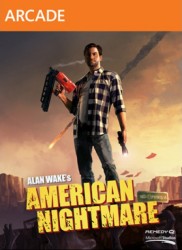
Format:
360 XBLA
Genre:
Adventuring
Style:
Thirdperson
Singleplayer
Further reading:
Alan Wake DLC expansions
Uncharted 3
Buy/Support:
Support Mark, click to buy via us...
Other GamePeople columnists have reviewed this from their perspective - huh?:
Reporting Gamer (360)
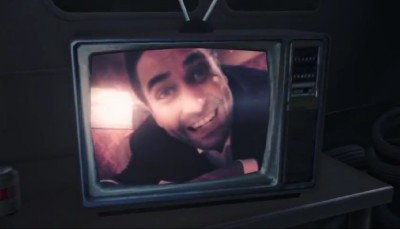
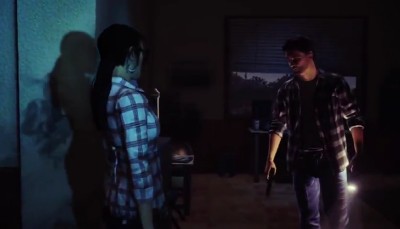
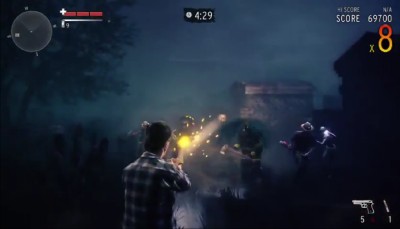
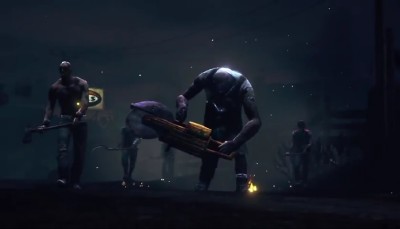
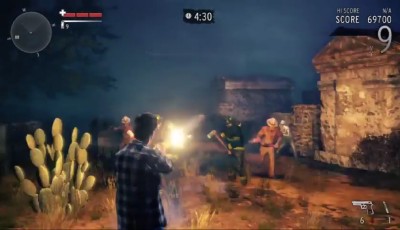

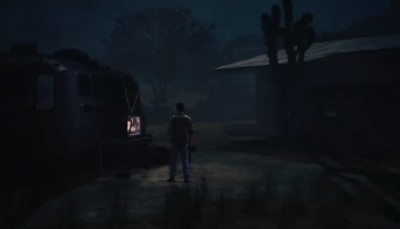
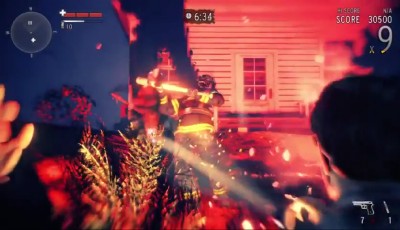

Further reading, films and books that create similar stories:
Alan Wake's American Nightmare XBLA 360 takes the self-absorbed author out of the woods and into the desert in an action-oriented mini-sequel.
Can Alan Wake work away from the town of Bright Falls and its surrounding countryside and woods? So much of the original game was about that environment and how Alan moved through it, the sheer panic of running through darkened woodland in the middle of the night, being pursued by the shadow-infected Taken, that it's hard to imagine him in any other setting.
Even the two Alan Wake DLC expansions purportedly set in the infinitely malleable dreamscape of the Dark Place beneath Cauldron Lake, heavily recycled locations and environmental elements from Bright Falls.
Alan Wake's American Nightmare, a downloadable, standalone follow-up to Alan's original adventure, changes location but does so while drawing from the mythology of the first game. The new location is Night Springs, the setting from the TV show of the same name that Alan used to write for, Twilight Zone-like episodes of which were seen in the first game as easter eggs.
While Night Springs felt like a fiction-within-a-fiction analog for Bright Falls in the first game, here it's relocated to the Arizona desert, pushed into existence via a weak spot in our reality. We don't really get to see the town as such, with Alan instead skipping between isolated locations in the desert, starting off with a motel and diner surrounded by broken-down railway carriages and derelict oil wells.
It's a different enough environment that Alan has ditched his trademark hoodie and jacket for a t-shirt and plaid shirt combo, but aside from the warm weather is it that much of a departure? A desert at night is, after all, as much of a distinctively American wilderness as the forests and hills of Bright Falls, so it might well seem like no change at all.
Well, not quite. There's something overly familiar and game-y about a desert, an environment that videogames have been able to render with reasonable efficiency for a good few years (ed: and was front and centre in Uncharted 3), so that instantly makes American Nightmare feel less visually distinct than its predecessor. Familiarity breeds content and undermines tension, and it doesn't help that, even at night, the desert landscape isn't all that gloomy, and scattered cacti don't do much to impede Alan's view of approaching enemies.
If the space feels too open to get trapped, it perversely manages to also lack the first game's disorienting sense of a sprawling wilderness. Running off the beaten track will find you walking into a harsh desert wind that brings Alan to a halt, an effective invisible wall revealing how tightly boxed in each level really is. While searching for manuscript pages and other easter eggs it's actually fairly easy work to jog around the entirety of each map without getting into too much Taken-dodging trouble.
It is, however a perfectly fine location for a more action-oriented variation on Alan's nighttime encounters with the Taken. Befitting American Nightmare's status as an Xbox Live Arcade title, the emphasis here is more on shoot-outs than survival, and the more open-yet-manageable expanses of Night Springs are entirely appropriate for the more frenetic action.
The sheer panic of running through darkened woodland in the middle of the night.
This shift from terrified fleeing to gleeful gunplay is possible because Night Springs is partially a platform for Alan's power fantasies, willed into being through his writerly powers.
The conceit here is that the blurry line between fiction and reality has turned a real desert town into the fictional Night Springs, and the game's story is framed as being an episode of the Night Springs TV show, complete with cheesy narration from an actor doing a fairly bad impersonation of the Twilight Zone's legendary creator/narrator Rod Serling.
Creating an environment based on Alan's own fiction is a neat extension of the theme of words having power that underlies the entire series, and theoretically gives developers Remedy licence to push the story and characters in a more fantastical and over the top direction, away from the sombre (and, frankly, pretentious) atmosphere of the first game, and to venture into B-movie, grindhouse themed territory.
It's not a licence that American Nightmare uses much, though. That super-cheesy narration aside, American Nightmare is only slightly more ridiculous and arch than Alan's troubled holiday in Bright Falls. The characters are a bit more stereotypical, the dialogue a bit more corny and on-the-nose, but it's not like the series has ever shied that far away from stock characters and duff dialogue. It's hard to see where the unselfconscious hack writing ends and the deliberate cheese begins.
He's less of a self-absorbed jerk, bending reality to empower himself as a self-made action hero.
Which is not to say that American Nightmare sees the series standing still - there's plenty of plot and character development on show here, as well as an evolution in the gameplay.
One of the most welcome is the evolution in Alan's character. Two years have passed since the events of the first game, and Alan has grown up in that time, gaining more control over his power to use fiction to influence fact, and improving himself in the process. He's less of a self-absorbed jerk, and more empowered, bending reality to empower himself as a self-made action hero.
In other words, he's both more likeable and far more heavily armed, gleefully wielding automatic weaponry and nail guns to tear apart a more fantastical array of Taken. Yep, the weakening of reality has souped them up too, from ordinary people tainted by darkness to giant mutants and slashing crow people.
At the centre of the chaos is Mr Scratch, Alan's identical double and manifestation of all his worse qualities. If Alan has improved as a person, it's because his flaws have gone walkabout on their own. While Alan can only temporarily step out into the real world, Mr Scratch is free to go wherever he pleases, debauching and killing while wearing Alan's face.
That's plenty of development for the mythology of the series, and the more bombastic arsenal and less ambiguous threats make for a mini-sequel that's more frenetic and action-oriented than its predecessor, and definitely less subtle.
In gameplay terms that's not too bad. A dilution of the scare-factor was always inevitable, as even in the course of the original game familiarity with the Taken reduced their shock factor. American Nightmare embraces this familiarity, and hones the torch-and-gun combat into an exciting, spinning dance as Alan drives back the Taken, stripping away their protective darkness before blowing them away. Throw in the odd flare or flashbang and battles can end truly spectacularly.
Old hands will be very comfortable, then, taking their survival skills and honing them into something more destructive, both in the Story Mode and in the addictive Arcade Action levels, which boil the combat down into an even purer form as you fight off waves of enemies for ten minutes.
Between the fights an interesting, looping story develops.
Back in Story Mode, between the fights an interesting, looping story develops, and a lot of back story and depth is added if you track down all the manuscript pages, radio and TV shows scattered throughout the game. You'll be missing out if you don't read the manuscript pages in particular, as they're crucial to the story, and to be honest I don't see why you would bother playing a story driven game like Alan Wake and not try and grab as much of the narrative as possible.
The radio shows have their own part to play in advancing the ongoing story, checking in on characters from the first game and where they've got to in two years. There's also an original rock song, Balance Slays The Demon, included in one of the shows, which is so awful there should be an achievement just for listening to it all the way through.
Weakest of all the easter eggs this time are the TV shows. The Night Springs episodes in the original game were quirky, uncanny little black and white playlets, which didn't make much sense but felt suitably weird. Sadly, not only has little of that off-kilter atmosphere transferred to the Night Springs that Alan has manifested in Arizona, but the in-game TVs just show videos of Mr Scratch ranting.
Sadly, little of that off-kilter atmosphere transferred to the Night Springs in Arizona.
While these fill in a bit of character and back story, they're not as interesting as the old TV shows, and they highlight the odd, possibly cost-saving decision to use live action for these mini-films and the major cut-scenes. There's something very dated and cheesy about switching to mugging, overdubbed actors for these sections, reminiscent of 1990s CD-Rom games.
Alan Wake's American Nightmare isn't perfect, then, but it is an interesting expansion of the Alan Wake universe, which provides a good chunk of story advancement and some exciting, shadow-blasting thrills. It's not the full sequel fans might be hoping for but there's a lot of content in American Nightmare, and developments in the series' mythology that leave plenty of room for future expansion.



Mark Clapham writes the Story Gamer column.
"I love a good story. Games tell many different stories: the stories told through cut scenes and dialogue, but also the stories that emerge through gameplay, the stories players make for themselves."
Here are the games I've been playing recently:
© GamePeople 2006-13 | Contact | Huh?

|
Family Video Game Age Ratings | Home | About | Radio shows | Columnists | Competitions | Contact
With so many different perspectives it can be hard to know where to start - a little like walking into a crowded pub. Sorry about that. But so far we've not found a way to streamline our review output - there's basically too much of it. So, rather than dilute things for newcomers we have decided to live with the hubbub while helping new readers find the columnists they will enjoy. |
Our columnists each focus on a particular perspective and fall into one of the following types of gamers:
|